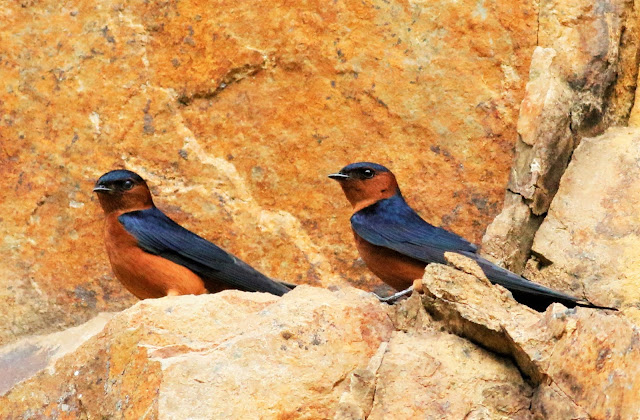Spring is in the air and it marked the start of an epic avian migration ever witnessed in this part of the hemisphere. By the time you read this post, the raptors of Pulau Rupat have already started their journey en-masse just like some of the wildebeest of Tanzania albeit in a slightly smaller scale. What triggers them (the birds) to start this epic journey? Do they follow the same route back to their breeding grounds? Are they all migrating at the same time? These are some of the intriguing questions which are often posed to the scientific community.
As a self-trained birdwatcher, i have always tried to find an answer to those questions. Perhaps i could find some of them in this vast grassland.
 |
| Oriental Honey Buzzard (OHB) |
From its features (greyish head and dark brown eyes), this OHB is certainly an adult male orientalis. (common morph). There were two of them and they were flying just above the tree tops and heading towards east. Question: could they have been heading for 'home' or are they just some resident OHBs? To answer those questions, there are two information leads which you could look for. Firstly the migratory form of orientalis are reported to be generally paler while the resident bird has darker underside. Secondly migratory raptors usually fly higher. However i could be wrong as some migratory raptors are known to "overnight" in their staging areas while waiting for the right time to continue their journey.
Unlike the above OHB, this forked-tailed swift (Apus pacificus) was heading north (towards Thailand) instead of eastwards.
 |
| Apus pacificus |
There were 5 of them but this one flew closes to me. Some reports have indicated that A.cooki is more common in open areas and in northern Peninsular Malaysia but i have identified the above swift as an A. pacificus based on its broader white rump band.
The same bird with a visibly large white band on its rump. Looks a bit like a tomahawk cruise missile.
Just like the above fork-tailed swift, these Oriental Pratincole (Glareola maldivarum) were also heading northwards.
 |
| Oriental Pratincole |
Although there have been breeding cases reported in Selangor, Kelantan and Kuantan in the past (Allen J & Pearson 2012), it will be quite difficult to determine whether these birds are actually resident birds or migrants. Perhaps a satellite transmitter can be placed on one of them to track their movements. If they were indeed migrant birds then they could have flown from as far as Indonesia and Australia.
I saw a total of 15 birds in a span of 10 - 15 minutes. They did not appear all at once but mostly in a single file, sometimes two and at the most 3.
I believe its much easier to differentiate "pratincole" while they are in flight rather than when they are aground. The absence of the white trailing edge to the wing should eliminate them from a "Collared Pratincole" (Glareola pratincola).
Note: they were once included in the "wader" category but now they are more or less a distinct species.
Most of them are already in their breeding colors - red-bill base.
From this anecdotal observation you can see that the above three species of birds (if they are indeed migrants) have chosen different routes in their spring migration. Does that also meant that some of them uses the land route while some would prefer the sea route?
More answers can perhaps emerged from the next few posts.
to be continued in Part 2......





























